Search engine optimization (SEO) is never complete—just ask Google.com: it doesn’t even follow its own guidelines for mobile performance, a critical ranking factor.
But by avoiding the most common technical SEO mistakes and keeping the user experience (UX) top of mind, you put your website in the position to rank higher and earn the organic clicks it deserves.
This guide shows you how to identify and fix 13 common SEO website issues using free and freemium tools. Stay on top of SEO performance to increase your online visibility and drive business growth by satisfying search engine algorithms and your website visitors.
What are ‘SEO issues’, and why should you fix them?
Common SEO problems usually fall into 3 categories:
Technical SEO issues: these are on-page SEO mistakes in your website’s code, like missing meta tags. Technical issues are usually one-time fixes that won’t require more work if you don’t make significant changes like moving to another content management system (CMS).
Off-site SEO issues: off-site problems are external factors that affect your site but are out of your control, like the backlinks other people build to your domain or duplicate content someone scraped. You’ll need to contact the offending website owners to fix these.
UX-based SEO issues: these are problems affecting real visitors’ enjoyment of your website. Metrics like bounce rate or time on page help measure UX issues, and these issues require ongoing maintenance and monitoring.
📝 Note: you’ll never get a perfectly ‘SEO-ed’ website (😭), but fixing common SEO and UX issues lets you improve visibility, get more qualified traffic, and, ultimately, generate more leads and sales.
13 common SEO issues with solutions
Use this checklist, based on information from Google’s Search Essentials and Bing’s Webmaster Guidelines, to find and fix common SEO issues and improve your rankings:
1. High bounce rate
Bounce rate is the percentage of website visitors who leave after viewing a single page.
Why it’s bad for SEO: a high bounce rate signals to search engines that users don’t find your content useful or relevant to their search, leading to lower rankings.
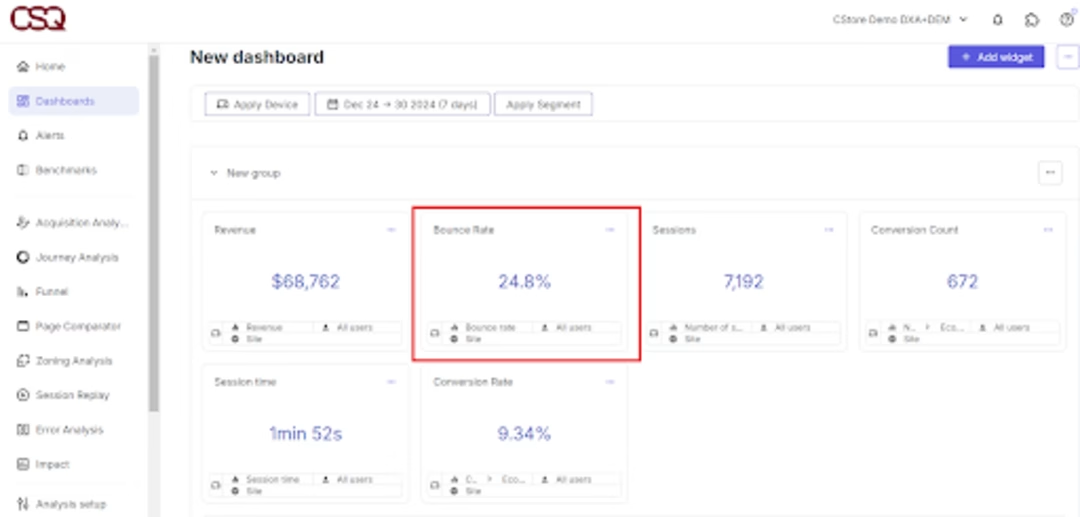
Check your website’s bounce rate in the Contentsquare dashboard
How to fix it: use a tool like Google Analytics or Contentsquare to find the pages on your website with the highest bounce rates.
Next, use a behavior analytics tool like session replays to view users’ actions before they bounce. When you see why users bounce—perhaps they got fed up waiting for the page to load or were confused by a broken link—you’ll know exactly what to fix to lower the bounce rate.
If you’re still not sure what’s causing high bounces, ask! Set up an exit-intent survey and ask people why they’re bouncing. A simple, open-ended, single-question survey gives you plenty of insight into what’s going through visitors’ minds as they browse, even if you only get a few responses.
💡Pro tip: combine Contentsquare’s Session Replay and Surveys tools for deeper insights into your bounce rate.
Use Session Replays to watch users’ actions before they leave, and leverage exit-intent surveys to ask them exactly why they’re bouncing. By cross-referencing behavior with direct feedback, you’ll pinpoint the real issues and make smarter fixes to keep users engaged longer.
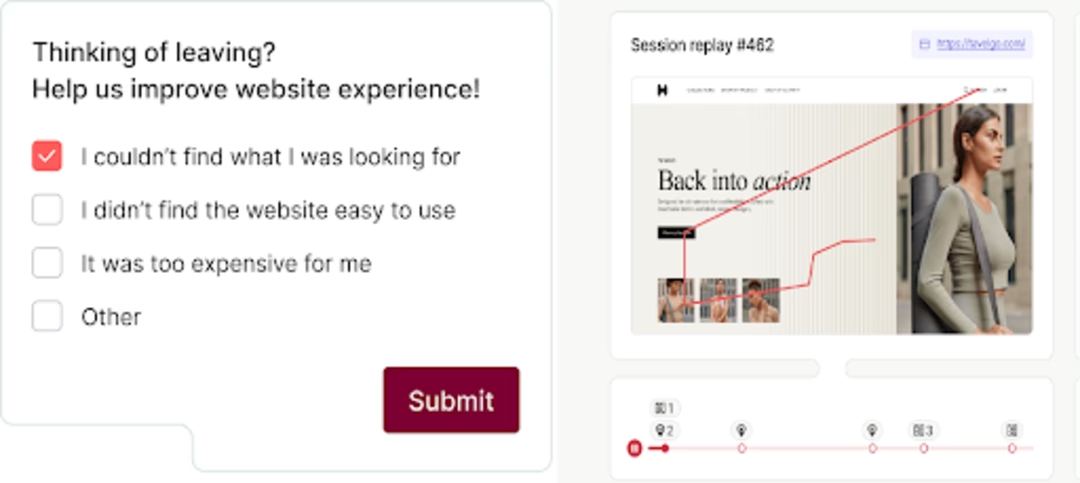
Use Contentsquare's Session Replay and Surveys tools to understand why users bounce and what to fix
2. Slow site speed
Site or page speed is a measurement of how quickly your pages load and render for users.
Why it’s bad for SEO: slow page speeds frustrate users, increasing the likelihood they bounce (see above). What's more, Google measures your site’s Core Web Vitals to determine website load time for real visitors and uses this data to increase or decrease your search rankings.
How to fix it: enter your domain name into a page speed testing tool and analyze how the entire website performs against Google’s Core Web Vitals assessment on desktop and mobile.
If you’re not scoring 100/100 (you won’t!), you may need to minify JavaScript and CSS or use a caching tool to improve your scores.
💡Pro tip: use Contentsquare’s Speed Analysis tool to track how your pages perform in real-time for mobile and desktop users. It lets you pinpoint slow-loading elements and prioritize fixes that will boost your page speed and, ultimately, your SEO performance.
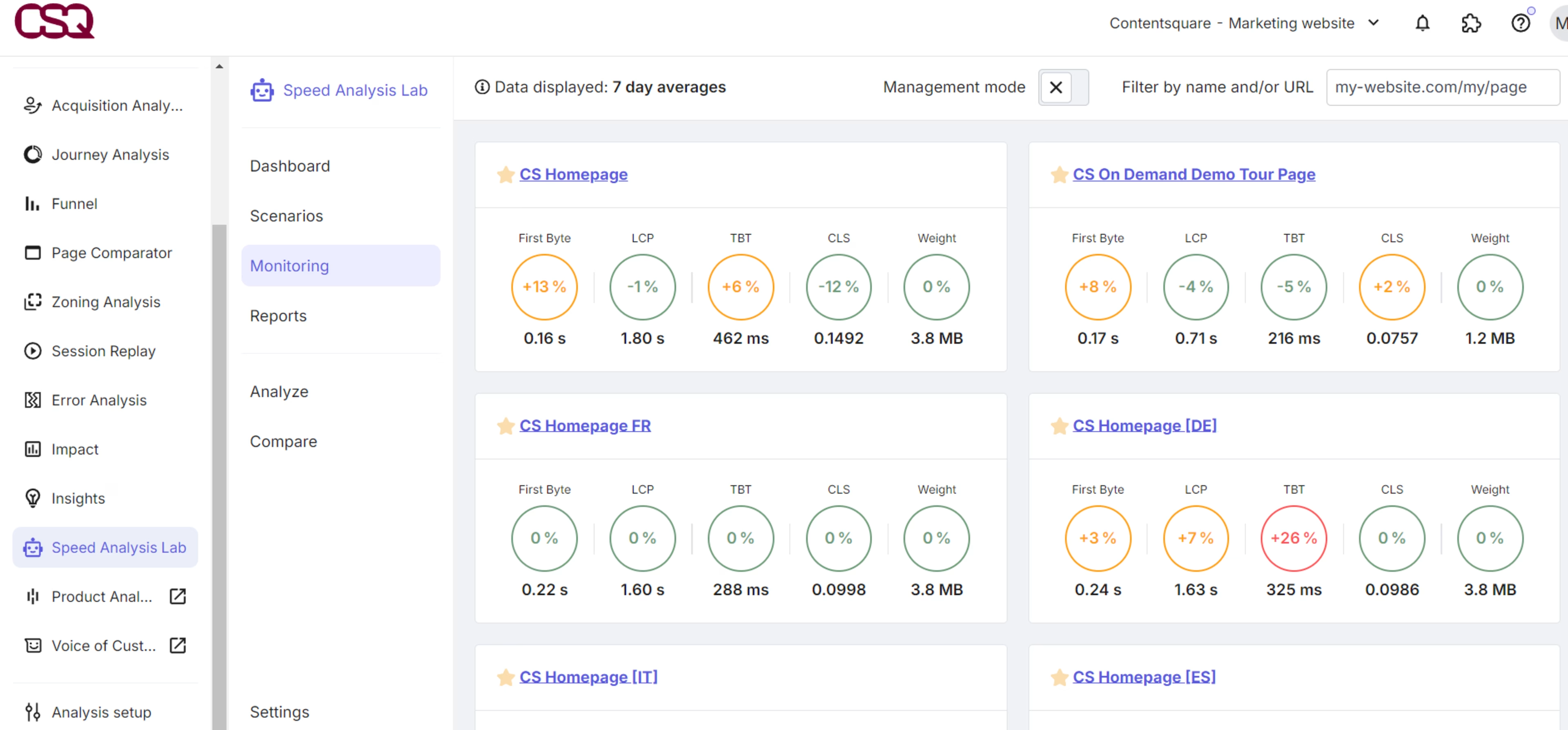
Monitor your website’s load times with Contentsquare’s Speed Analysis tool and improve your SEO ranking
3. Broken links and 404 errors
When links lead to pages that no longer exist, they become broken links, and attempting to access them triggers a 404 error. This applies to both internal and external links.
Why it’s bad for SEO: Broken links and the resulting 404 errors not only create a frustrating experience for users but also hinder search engine crawlers from finding and passing authority to other pages on your site, ultimately affecting its ranking and visibility.
How to fix it: use a tool like Contentsquare’s Error Analysis to identify JavaScript, API, and 404 errors affecting your website’s performance. Once identified, prioritize resolving these errors, as they can disrupt the user journey.
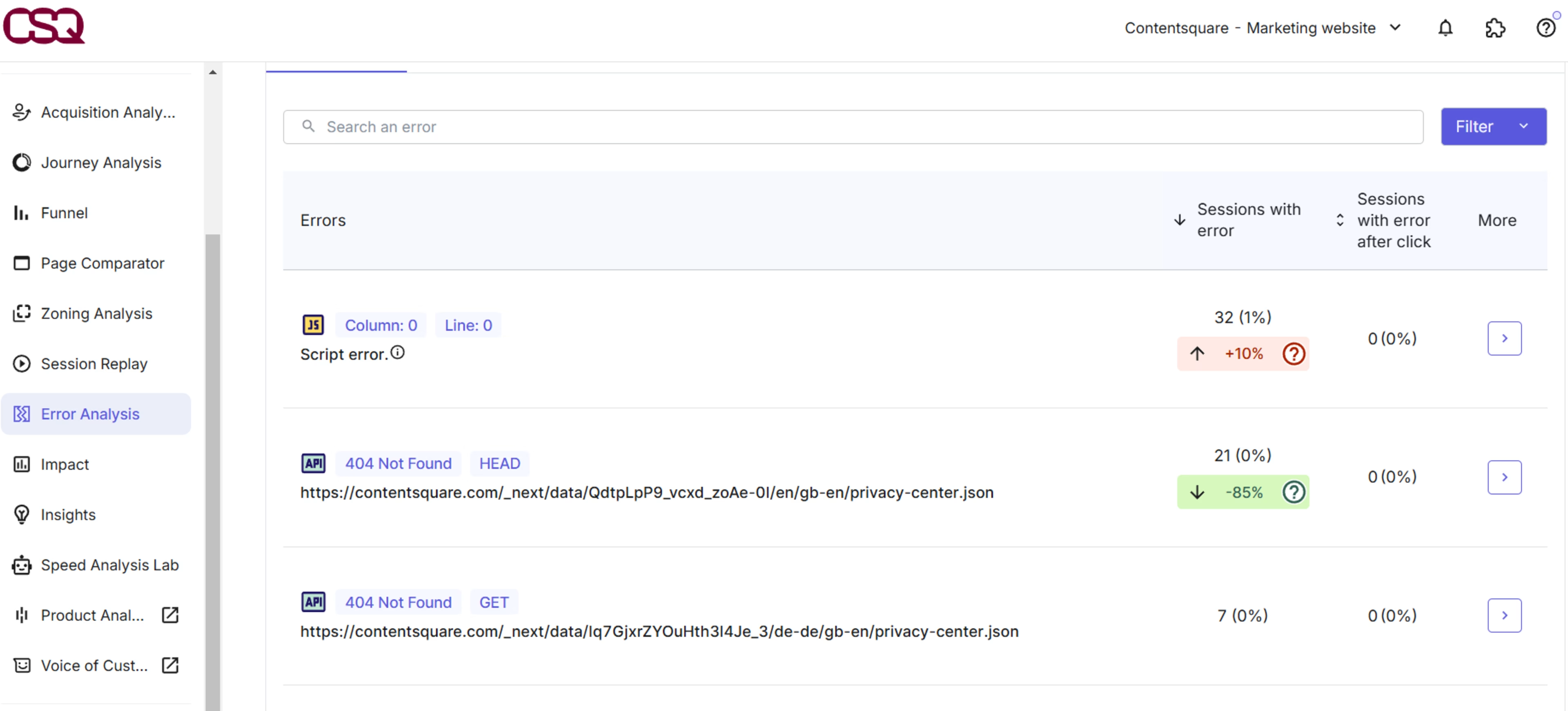
Use Contentsquare’s Error Analysis tool to identify and fix dead-end pages harming your SEO ranking
To fix broken inbound links (i.e. broken links pointing to your domain from other websites), you’ll need to reach out to the site owners to change them. A quicker fix is to 301 redirect any broken inbound link to a relevant live page.
4. Low-quality content
Low-quality or ‘thin’ content is, according to Google, unhelpful, unreliable, and search engine-first.
Why it’s bad for SEO: poor content leads to bad user experience signals like high bounce rate and low time on page. These signals, alongside real human search quality raters, cause search engines to suppress content on the search engine results pages (SERPs).
How to fix it: familiarize yourself with Google’s helpful content guidelines and make sure you can answer ‘yes’ to questions like, “After reading your content, will someone leave feeling like they've learned enough about a topic to help achieve their goal?”
Instead of guessing if your content is helpful, you can simply ask your readers directly. Use Contentsquare’s Surveys tool to ask visitors if they’ve found what they needed and, if not, what they were looking for. Worst-case scenario, you’ll get plenty of good keyword ideas for future content.
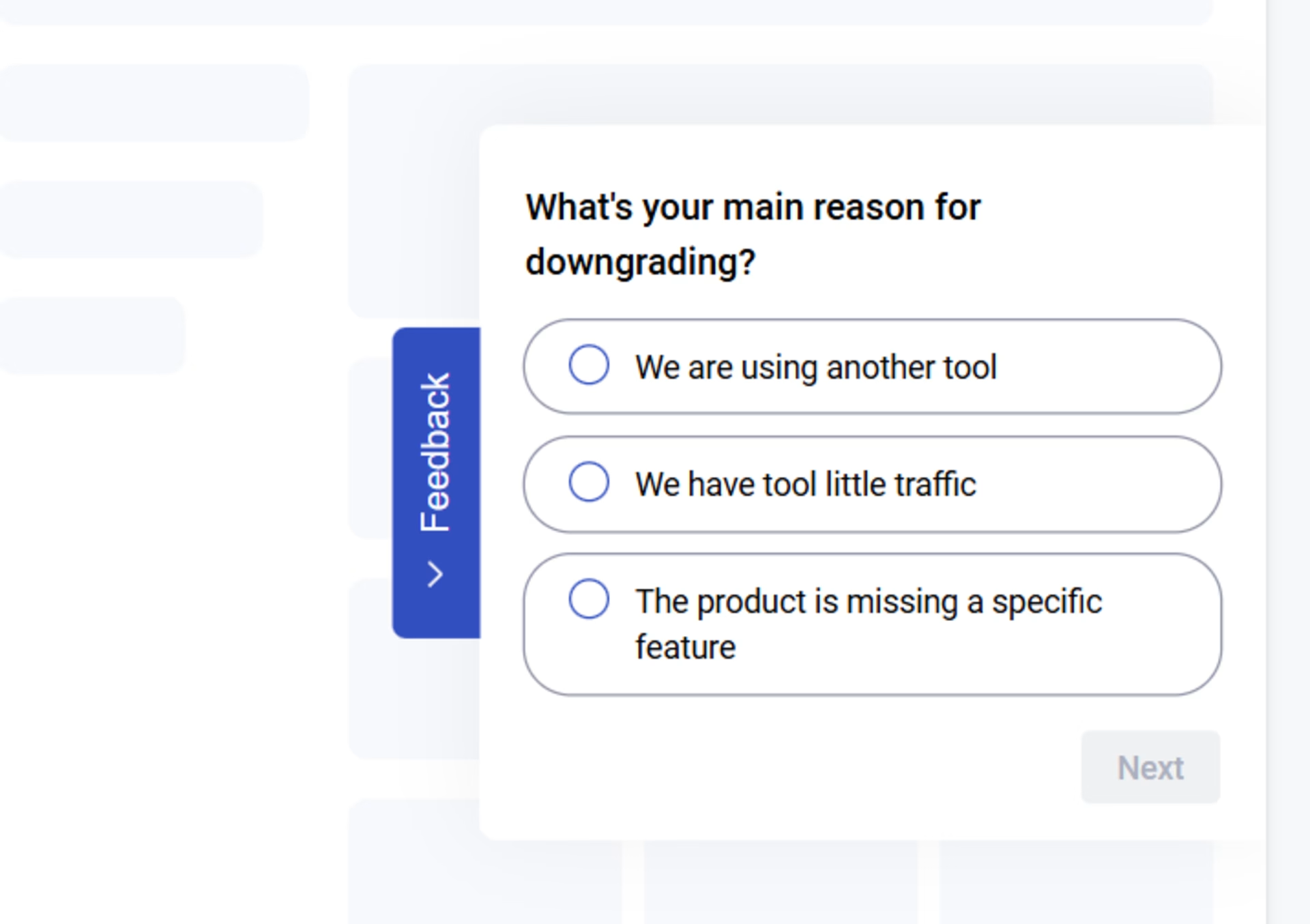
Place Contentsquare Surveys on your pages to improve content
5. Missing or unoptimized title tags
A <title> tag is an HTML page title shown as the title of a search result.
Why it’s bad for SEO: page titles are the largest element on the SERP, and people read them to decide if your pages are worth clicking on. A long or unoptimized title could make you lose out on clicks. What’s more, search engines use SERP click-through rate (CTR) to decide which pages should rank highly.

How the <title> for our guide to replays looks in the SERP
How to fix it: first, make sure your pages use title tags by inspecting the source code (in Chrome, go to View > Developer > View Source and search for ‘<title>’). Add or optimize your titles to describe the page contents and give people a reason to click through.
Google (or Bing) your primary keyword, and imagine your title competing for clicks with the top results. Use a SERP preview tool like this free one from Portent to play around with title ideas that fit the recommended length and visualize how they'll appear on the SERP.
📝 Note: most search engines rewrite page titles, but there’s less chance of this if you write good ones yourself first.
6. Poor site structure and navigation
Site structure and navigation refer to how your web pages are organized and connected using links and menus.
Why it’s bad for SEO: poor navigation means people won’t find what they're looking for, making them more likely to get frustrated and bounce.
As we mentioned above, a high bounce rate indicates to search engines that your website is not worth promoting. Poor site structure also makes it harder for search engines to index your site and pass authority to important pages.
How to fix it: use a tool like Contentsquare Heatmaps on your website to visualize where people click on your menu and page links on desktop and mobile.
Are you getting clicks where you want them? Are you wasting space on menu categories that nobody clicks? Use these insights to get better ideas for navigation improvements and A/B tests instead of trying to guess what might work for your users.
![[Blog ] Predictive personalization - Comparator IMAGE](http://images.ctfassets.net/gwbpo1m641r7/ANj20vBXBWxkCHWIvAE7w/9a33e43b8b285fdc49f14b7c4d11a979/Side-by-side_analysis.png?w=3840&q=100&fit=fill&fm=avif)
Contentsquare Heatmaps help you validate assumptions and guide your A/B tests
7. Missing SSL certificate
An SSL (Secure Sockets Layer) certificate encrypts the connection between your website and visitors—you’ll usually see https:// or a padlock icon in the browser if it’s working.
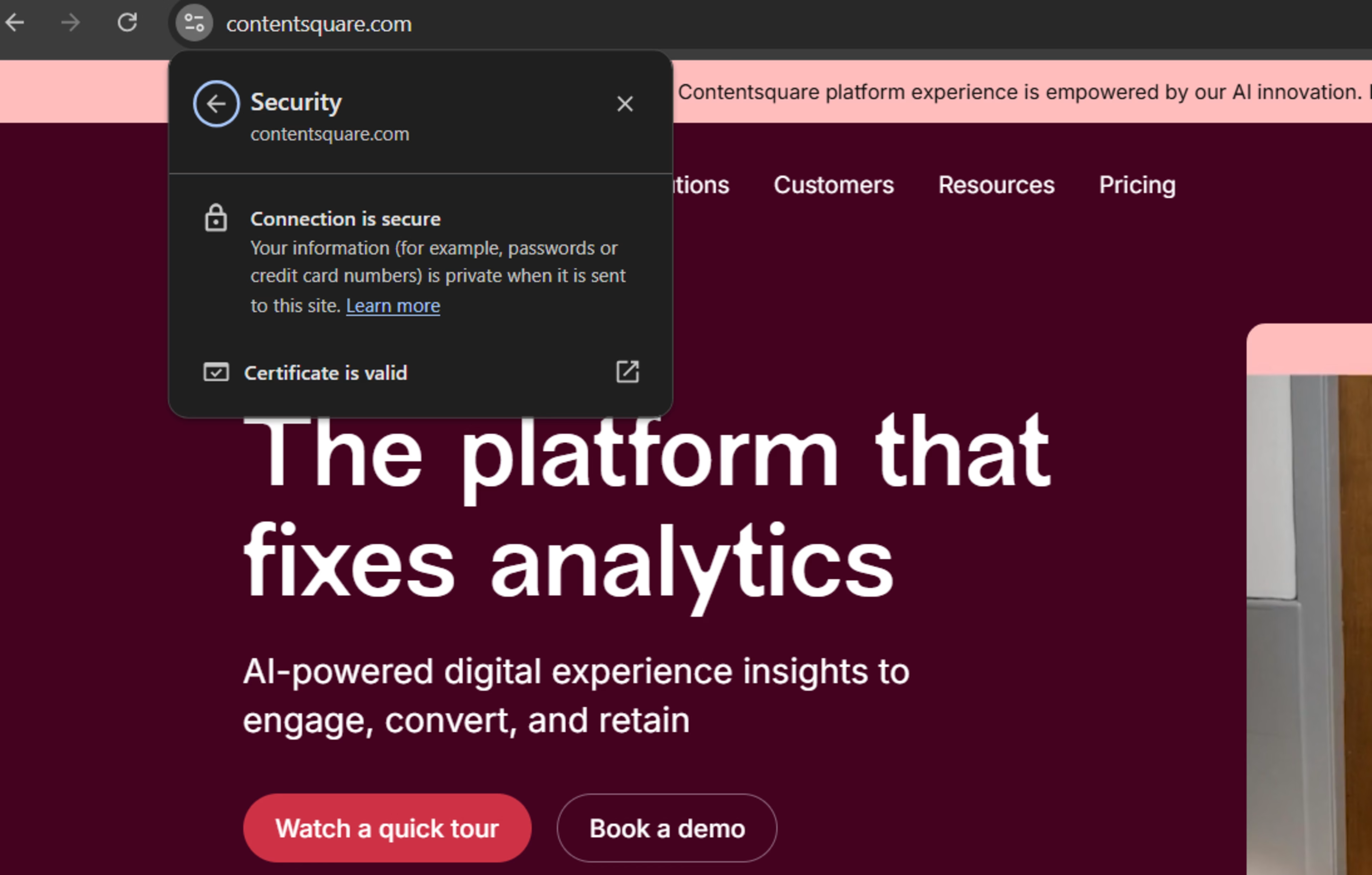
Contentsquare.com’s SSL certificate
Why it’s bad for SEO: a missing, broken, or expired SSL certificate can lead to visitors getting a ‘not secure’ warning on popular browsers like Google Chrome, which is likely to increase your bounce rate. Additionally, search engines use HTTPS as a positive ranking signal.
How to fix it: check if you have an SSL certificate by entering your domain into a free SSL checker tool like Why No Padlock. If you don’t, set up one through your website hosting provider or a certificate issuer like Let’s Encrypt.
8. Missing image alt tags
Image alt tags are HTML tags that attach a written description to images and can be read by search engine crawlers and accessibility tools like screen readers.
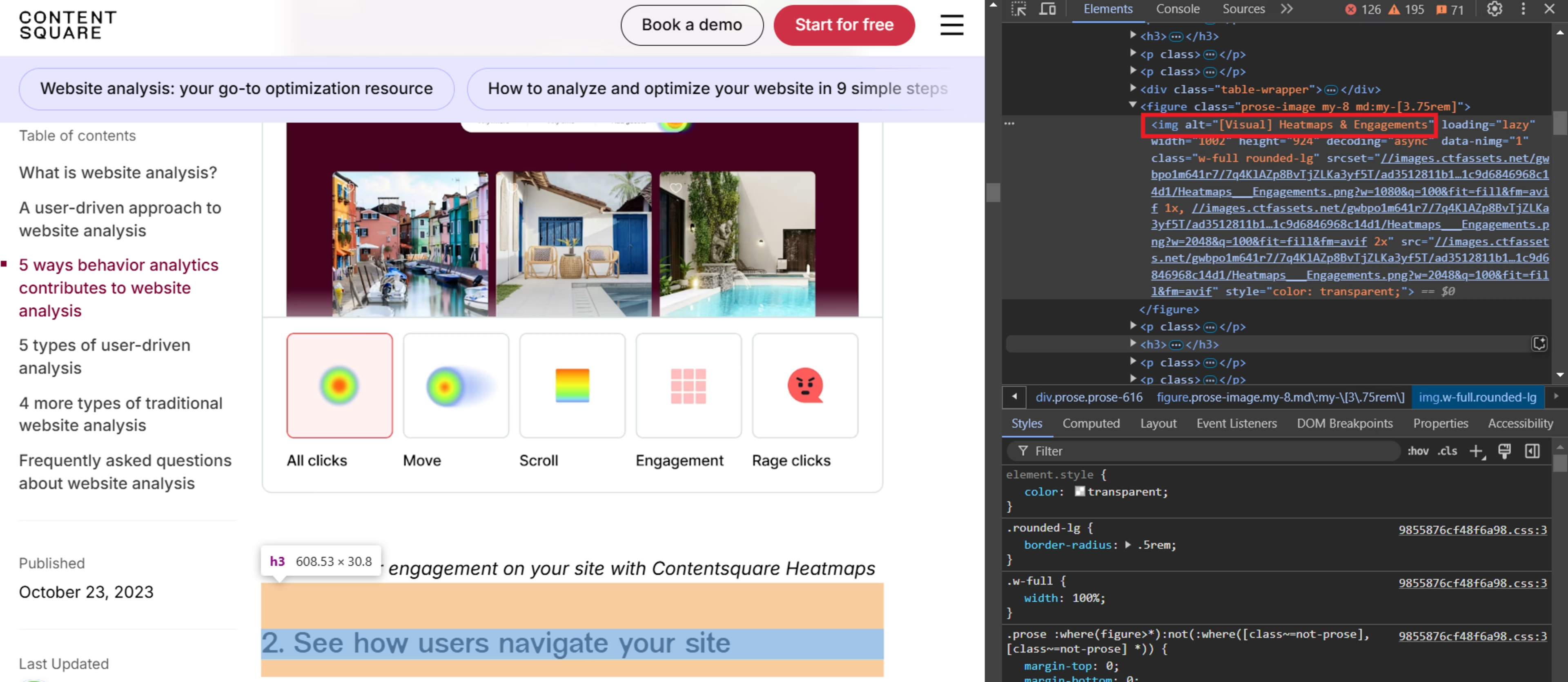
Image alt text for an illustration on our guide to website analysis
Why it’s bad for SEO: missing alt tags make your content less accessible to users with screen reading tools or low-bandwidth connections. That's—you guessed it!—bad for user experience and could increase your bounce rate.
Search engine crawlers also use alt text to interpret a page’s contents, so leaving it out loses you the opportunity to give them more clues about how relevant your page is.
How to fix it: to check if you’re using image alt text, visit your website on Google Chrome and use the built-in developer tools to run an accessibility check (View > Developer > Developer Tools > Lighthouse).
Follow Google’s image guidelines and create descriptive alt text (e.g. ‘an image of a website heatmap showing user clicks’) instead of keyword-stuffing (e.g. ‘heatmap, heat map, HEATMAP’).
9. Missing or outdated XML sitemap
An XML sitemap is a file that catalogs your website’s pages—or other content like images, videos, or news—and when they were last modified.
Why it’s bad for SEO: search engine crawlers, including Googlebot and Bingbot, use XML sitemaps to crawl and recrawl your content. A missing or outdated sitemap could mean it takes longer for search engines to find your pages (or page updates) and rank you accordingly.
How to fix it: create an XML sitemap using your CMS (for example, with a WordPress plugin like XML Sitemaps) or an XML generator tool like XML-Sitemaps.com.
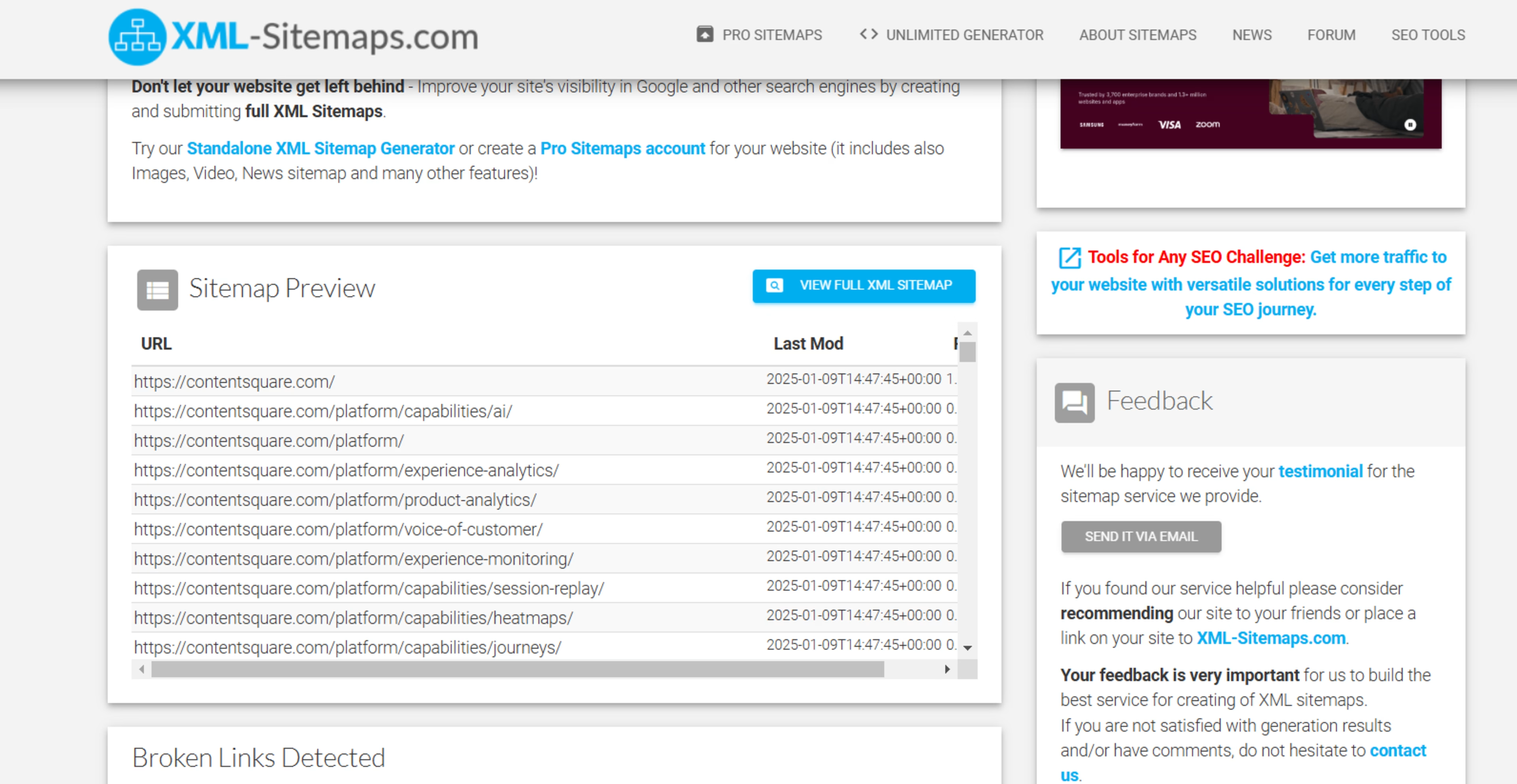
XML sitemap generated for Contentsquare.com
Check that search engines know where your XML sitemap is located by submitting it to Google Search Console’s sitemaps report and Bing Webmaster Tools’ sitemaps tool.
10. Lack of schema markup
Schema markup is structured data (aka microdata) that helps search engines read and categorize content entities like a product listing or an FAQ section. The structured data standard is managed by Schema.org.
Why it’s bad for SEO: without schema markup, search engines can’t classify your website content. You’ll miss out on rich snippets—coveted SERP real estate that improves CTR, like review star ratings or product prices.
How to fix it: check the schema markup on your existing pages using Schema.org’s validator tool and check which rich snippets your page can generate by pasting any URL into Google’s Rich Results Test. To implement schema markup, follow the relevant guide from Schema.org’s full list of available schemas.
11. Duplicate content
Duplicate content is any piece of content that exists in multiple places on a single website or across multiple sites at once.
Why it’s bad for SEO: duplicate content can lead to the wrong page being ranked in search engines or waste your site’s crawl budget (the resources a search engine is willing to spend crawling your website) on irrelevant pages.
How to fix it: use a site audit tool like Siteliner to crawl your website and find duplicate content. Look at duplicate pages and add rel=canonical tags to let search engines know which page should be indexed. Add a no-index tag to duplicate content you don’t want appearing in search engines.
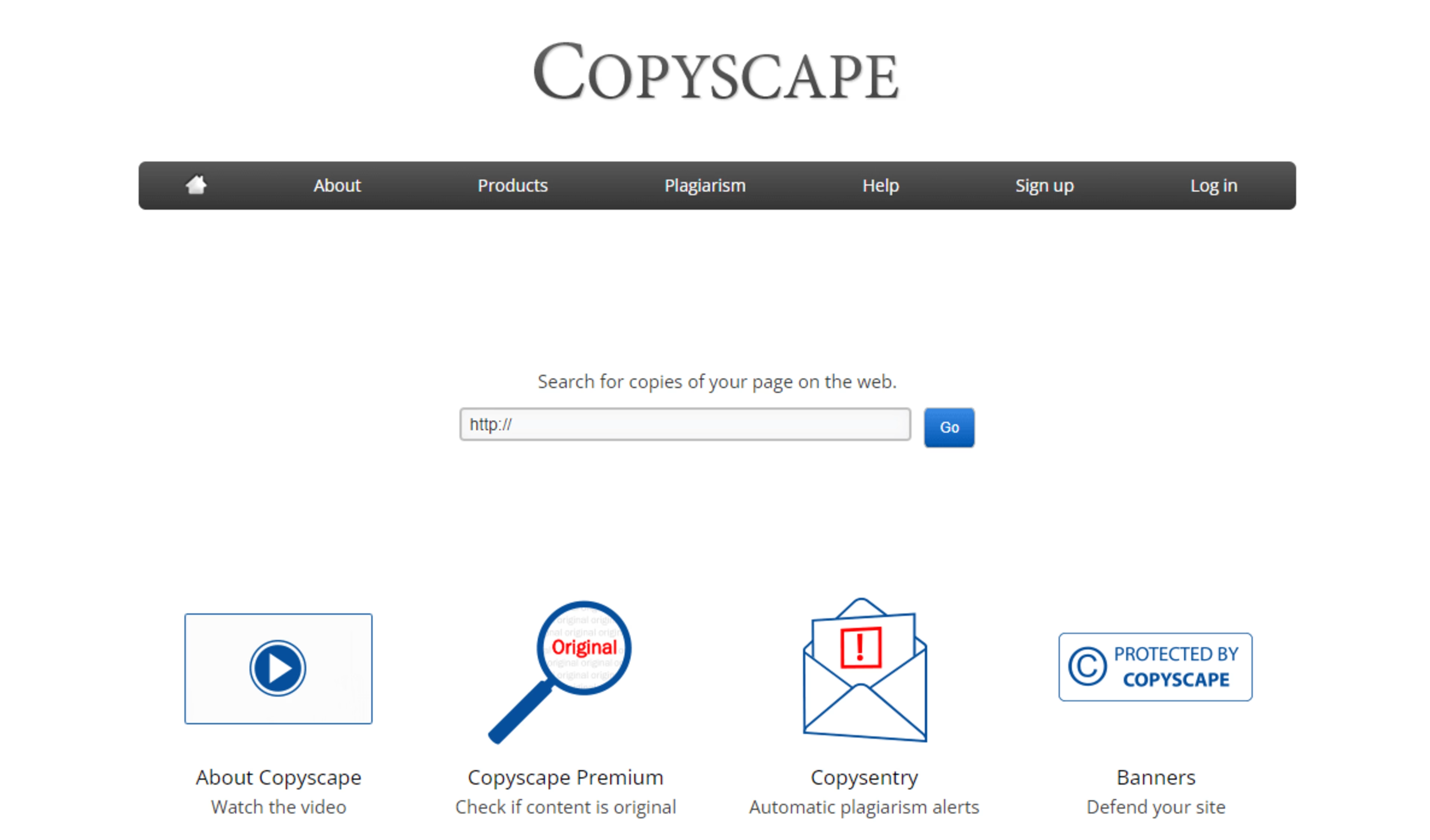
Copyscape lets you detect copies of your page on the web
To find out if your content has been published on external websites, paste some body text into Google or use a duplicate-content-checking tool like Copyscape. If you find someone’s scraped entire pages from your website, contact the site owner, domain registrar, or hosting provider to get the duplicate content removed.
12. Missing hreflang attributes
Hreflang is an HTML attribute that specifies a web page’s language and geographical target.
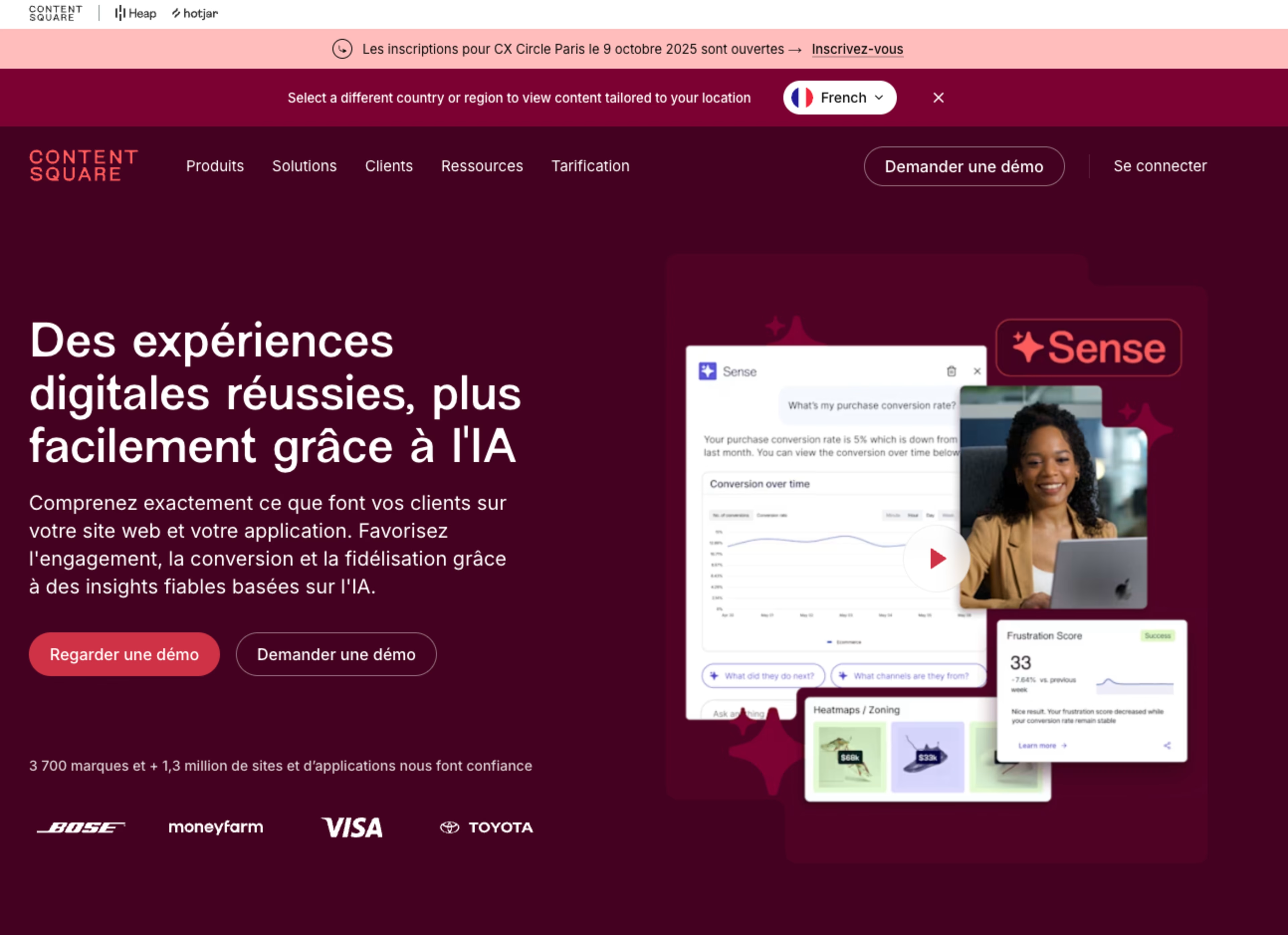
Why it’s bad for SEO: if your website is serving content in multiple languages or locales (e.g. US English and UK English), missing or incorrect hreflang attributes could lead to the wrong content ranking in different countries, negatively affecting SERP CTR and bounce rate.
How to fix it: use an hreflang testing tool like Hreflang Checker to check if you’ve got hreflang tags on your pages. Add hreflang elements to your page header to indicate every language and region variant of a page.
13. Poor mobile experience
Mobile experience measures the UX of mobile device users who browse on their smartphones or tablets.
Why it’s bad for SEO: Google uses mobile-first indexing, which means they use your website’s mobile performance and UX to decide on its ranking—even for desktop users. Giving visitors a poor mobile browsing experience hurts your search engine rankings across all devices.
How to fix it: use Google’s Lighthouse tool to check how the search engine grades your mobile usability. You can fix common mobile website issues with a website analysis platform like Contentsquare. Looking at how real mobile users browse your website shows you what bugs need fixing and gives you ideas to improve mobile UX.
For example, MyDeal, an Australian online retail marketplace, used Contentsquare Heatmaps to analyze how mobile users interacted with their homepage product carousels. They discovered that optimizing these carousels led to a 336% increase in revenue from this section and significantly enhanced the mobile user experience.
![[Customer Story] [MyDeal] Carousel engagement](http://images.ctfassets.net/gwbpo1m641r7/qjEqU8r8bUzAKg2kwYKJk/5e3b438a6b1460dec8ed39ac9d5c4a92/Frame_1__1_.png?w=3840&q=100&fit=fill&fm=avif)
The difference in MyDeal’s carousel engagement rates from the top of the homepage (left, 1.68%) to the end of the homepage (right, 7.84%)
Mobile-first design optimizations like this one help you convert more visitors into customers while also satisfying Googlebot and supporting your SEO efforts. Win-win!
Make UX the centerpiece of every SEO project
Most common SEO issues and mistakes can be fixed with simple technical changes—and there’s no lack of helpful SEO guides for beginners, starting with SEO writing.
But once you’ve covered the basics, there’s not much more you can do to rank better with website code alone. The secret to continual ranking improvements isn’t technical: it’s human.
Start with Contentsquare by using Heatmaps and Session Replays to watch real users in the wild: what content do they respond to? What makes them bounce? Then, reach out and talk to real customers: ask them for feedback by using VoC tools like Surveys and Interviews.
Use their words to inform your keyword research and organize your content marketing ideas around their pain points and jobs to be done. This way, you give users and search engines what they want.
FAQs about common SEO issues
![[Visual] [Guide] [Website problems] SEO](http://images.ctfassets.net/gwbpo1m641r7/5fgh5kBHLYQTjIoCmESkLU/37653ddba27d5f15f1f16f119c24a268/pexels-diva-plavalaguna-5711501.jpg?w=3840&q=100&fit=fill&fm=avif)

![[Visual] NPS Tracking Header](http://images.ctfassets.net/gwbpo1m641r7/7aCsV4BL8pN29lZnPhpikT/c0f944d4785bb65d5a11d8f44b0610fc/jonathan-francisca-Q-y8EsExqYA-unsplash.jpg?w=1920&q=100&fit=fill&fm=avif)
![[visual] Dive into the best marketing platforms and solutions for ecommerce sites.](http://images.ctfassets.net/gwbpo1m641r7/2r9Wv5DAaiQLVqnEK5abEs/faf9ba01de9f7d6e27678df92db1c829/pexels-artempodrez-8518650.jpg?w=1920&q=100&fit=fill&fm=avif)